Comprehensive Analysis of Tesco's Marketing Principles and Strategies
VerifiedAdded on 2019/12/03
|10
|2592
|183
Report
AI Summary
This report provides a comprehensive analysis of Tesco's marketing strategies, focusing on the application of the marketing mix (product, place, price, and promotion) and its extended elements. The report examines Tesco's structured product development plan, detailing each step from idea generation to product launch. It explores Tesco's distribution channels, including offline (superstores, express, metro, and extra) and online platforms. The pricing strategies, encompassing demand and competitive pricing, are also discussed. Furthermore, the report delves into Tesco's promotional activities, outlining the steps involved in designing promotional plans and the use of various promotional tools. The report also considers the extended marketing mix elements of people, process, and physical evidence. Finally, it provides a comparative analysis of marketing strategies for Tesco mobile, marketing for business versus consumers, and international versus domestic marketing, offering valuable insights into Tesco's marketing approach and its adaptation to different contexts.
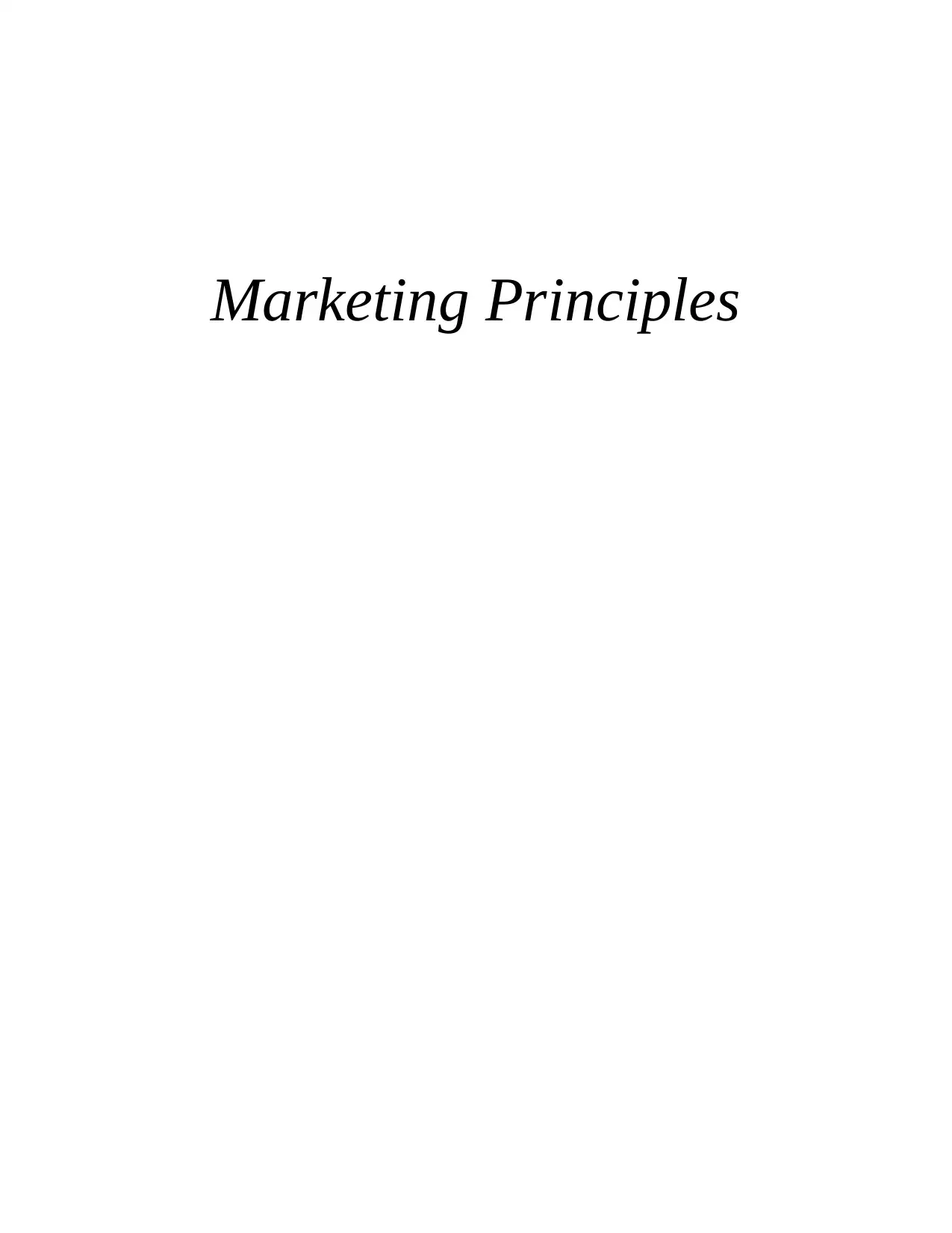
Marketing Principles
Paraphrase This Document
Need a fresh take? Get an instant paraphrase of this document with our AI Paraphraser
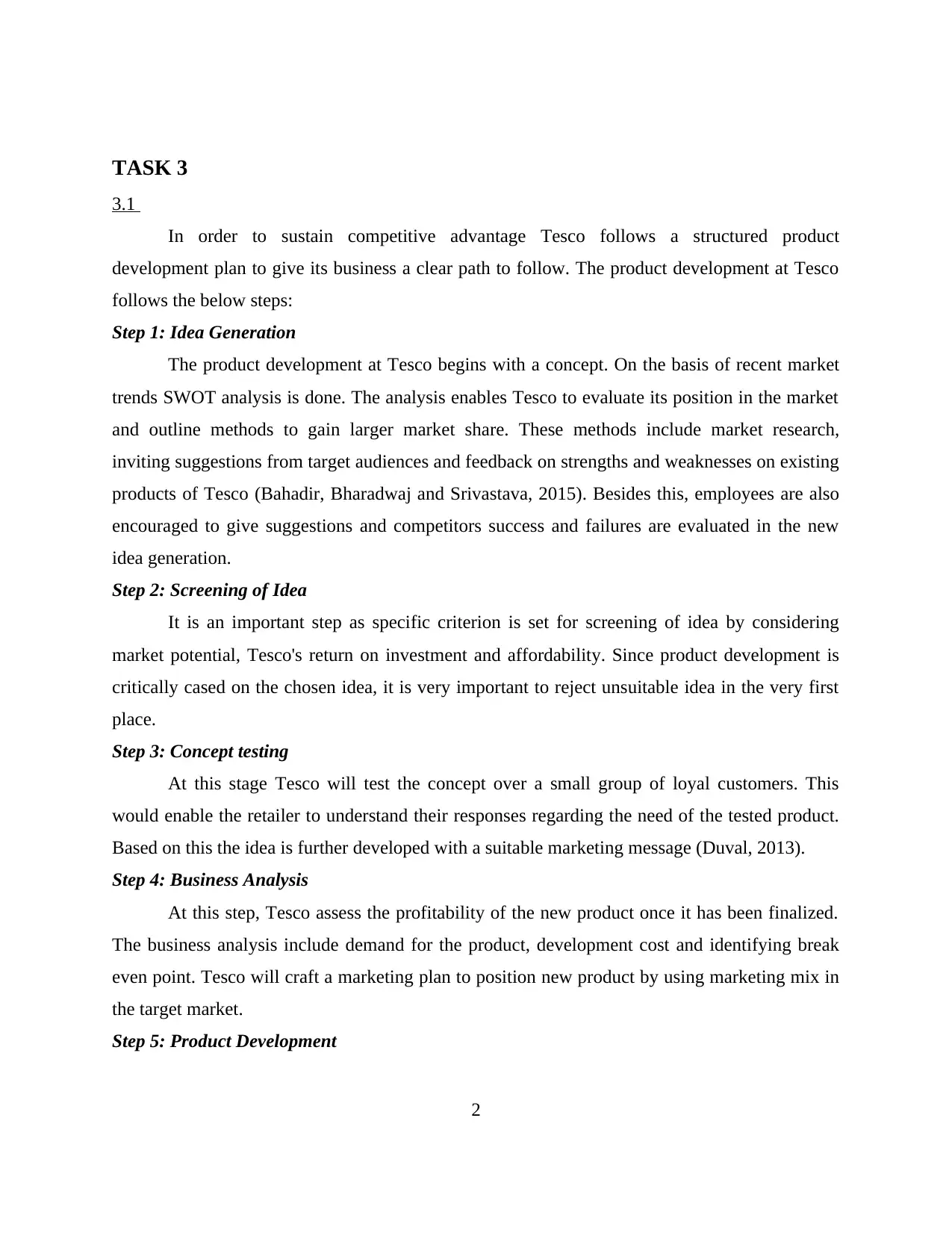
TASK 3
3.1
In order to sustain competitive advantage Tesco follows a structured product
development plan to give its business a clear path to follow. The product development at Tesco
follows the below steps:
Step 1: Idea Generation
The product development at Tesco begins with a concept. On the basis of recent market
trends SWOT analysis is done. The analysis enables Tesco to evaluate its position in the market
and outline methods to gain larger market share. These methods include market research,
inviting suggestions from target audiences and feedback on strengths and weaknesses on existing
products of Tesco (Bahadir, Bharadwaj and Srivastava, 2015). Besides this, employees are also
encouraged to give suggestions and competitors success and failures are evaluated in the new
idea generation.
Step 2: Screening of Idea
It is an important step as specific criterion is set for screening of idea by considering
market potential, Tesco's return on investment and affordability. Since product development is
critically cased on the chosen idea, it is very important to reject unsuitable idea in the very first
place.
Step 3: Concept testing
At this stage Tesco will test the concept over a small group of loyal customers. This
would enable the retailer to understand their responses regarding the need of the tested product.
Based on this the idea is further developed with a suitable marketing message (Duval, 2013).
Step 4: Business Analysis
At this step, Tesco assess the profitability of the new product once it has been finalized.
The business analysis include demand for the product, development cost and identifying break
even point. Tesco will craft a marketing plan to position new product by using marketing mix in
the target market.
Step 5: Product Development
2
3.1
In order to sustain competitive advantage Tesco follows a structured product
development plan to give its business a clear path to follow. The product development at Tesco
follows the below steps:
Step 1: Idea Generation
The product development at Tesco begins with a concept. On the basis of recent market
trends SWOT analysis is done. The analysis enables Tesco to evaluate its position in the market
and outline methods to gain larger market share. These methods include market research,
inviting suggestions from target audiences and feedback on strengths and weaknesses on existing
products of Tesco (Bahadir, Bharadwaj and Srivastava, 2015). Besides this, employees are also
encouraged to give suggestions and competitors success and failures are evaluated in the new
idea generation.
Step 2: Screening of Idea
It is an important step as specific criterion is set for screening of idea by considering
market potential, Tesco's return on investment and affordability. Since product development is
critically cased on the chosen idea, it is very important to reject unsuitable idea in the very first
place.
Step 3: Concept testing
At this stage Tesco will test the concept over a small group of loyal customers. This
would enable the retailer to understand their responses regarding the need of the tested product.
Based on this the idea is further developed with a suitable marketing message (Duval, 2013).
Step 4: Business Analysis
At this step, Tesco assess the profitability of the new product once it has been finalized.
The business analysis include demand for the product, development cost and identifying break
even point. Tesco will craft a marketing plan to position new product by using marketing mix in
the target market.
Step 5: Product Development
2
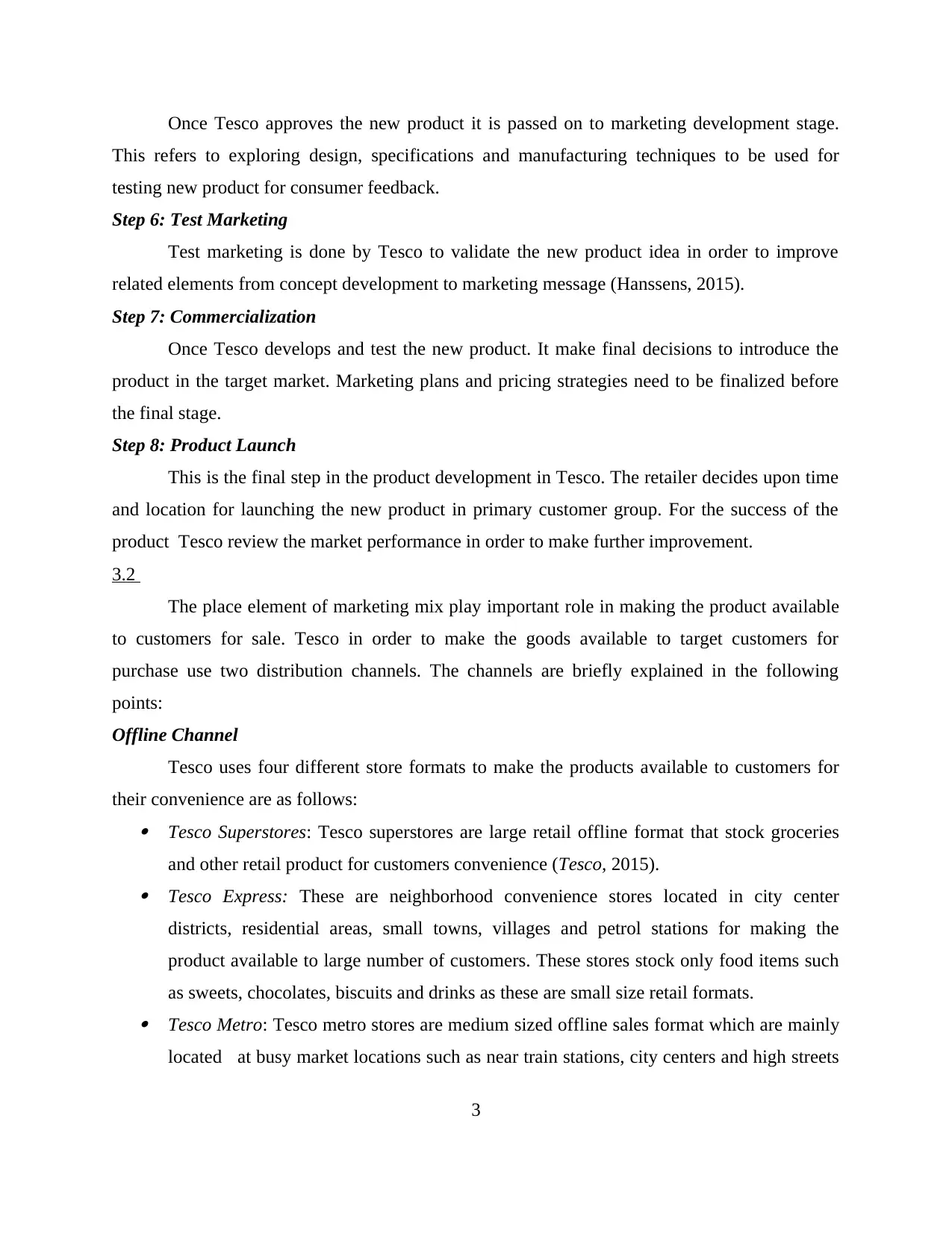
Once Tesco approves the new product it is passed on to marketing development stage.
This refers to exploring design, specifications and manufacturing techniques to be used for
testing new product for consumer feedback.
Step 6: Test Marketing
Test marketing is done by Tesco to validate the new product idea in order to improve
related elements from concept development to marketing message (Hanssens, 2015).
Step 7: Commercialization
Once Tesco develops and test the new product. It make final decisions to introduce the
product in the target market. Marketing plans and pricing strategies need to be finalized before
the final stage.
Step 8: Product Launch
This is the final step in the product development in Tesco. The retailer decides upon time
and location for launching the new product in primary customer group. For the success of the
product Tesco review the market performance in order to make further improvement.
3.2
The place element of marketing mix play important role in making the product available
to customers for sale. Tesco in order to make the goods available to target customers for
purchase use two distribution channels. The channels are briefly explained in the following
points:
Offline Channel
Tesco uses four different store formats to make the products available to customers for
their convenience are as follows: Tesco Superstores: Tesco superstores are large retail offline format that stock groceries
and other retail product for customers convenience (Tesco, 2015). Tesco Express: These are neighborhood convenience stores located in city center
districts, residential areas, small towns, villages and petrol stations for making the
product available to large number of customers. These stores stock only food items such
as sweets, chocolates, biscuits and drinks as these are small size retail formats. Tesco Metro: Tesco metro stores are medium sized offline sales format which are mainly
located at busy market locations such as near train stations, city centers and high streets
3
This refers to exploring design, specifications and manufacturing techniques to be used for
testing new product for consumer feedback.
Step 6: Test Marketing
Test marketing is done by Tesco to validate the new product idea in order to improve
related elements from concept development to marketing message (Hanssens, 2015).
Step 7: Commercialization
Once Tesco develops and test the new product. It make final decisions to introduce the
product in the target market. Marketing plans and pricing strategies need to be finalized before
the final stage.
Step 8: Product Launch
This is the final step in the product development in Tesco. The retailer decides upon time
and location for launching the new product in primary customer group. For the success of the
product Tesco review the market performance in order to make further improvement.
3.2
The place element of marketing mix play important role in making the product available
to customers for sale. Tesco in order to make the goods available to target customers for
purchase use two distribution channels. The channels are briefly explained in the following
points:
Offline Channel
Tesco uses four different store formats to make the products available to customers for
their convenience are as follows: Tesco Superstores: Tesco superstores are large retail offline format that stock groceries
and other retail product for customers convenience (Tesco, 2015). Tesco Express: These are neighborhood convenience stores located in city center
districts, residential areas, small towns, villages and petrol stations for making the
product available to large number of customers. These stores stock only food items such
as sweets, chocolates, biscuits and drinks as these are small size retail formats. Tesco Metro: Tesco metro stores are medium sized offline sales format which are mainly
located at busy market locations such as near train stations, city centers and high streets
3
⊘ This is a preview!⊘
Do you want full access?
Subscribe today to unlock all pages.

Trusted by 1+ million students worldwide
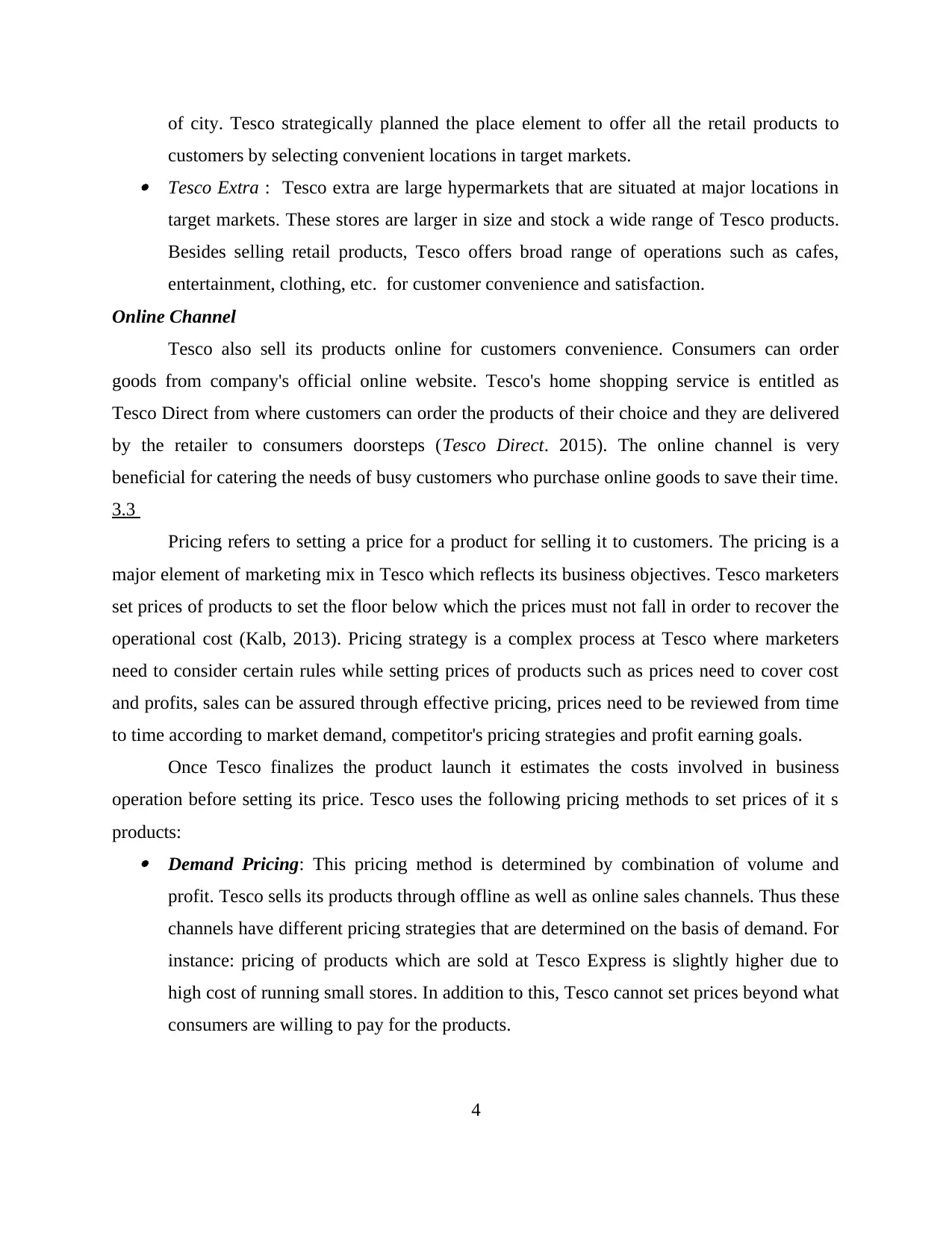
of city. Tesco strategically planned the place element to offer all the retail products to
customers by selecting convenient locations in target markets. Tesco Extra : Tesco extra are large hypermarkets that are situated at major locations in
target markets. These stores are larger in size and stock a wide range of Tesco products.
Besides selling retail products, Tesco offers broad range of operations such as cafes,
entertainment, clothing, etc. for customer convenience and satisfaction.
Online Channel
Tesco also sell its products online for customers convenience. Consumers can order
goods from company's official online website. Tesco's home shopping service is entitled as
Tesco Direct from where customers can order the products of their choice and they are delivered
by the retailer to consumers doorsteps (Tesco Direct. 2015). The online channel is very
beneficial for catering the needs of busy customers who purchase online goods to save their time.
3.3
Pricing refers to setting a price for a product for selling it to customers. The pricing is a
major element of marketing mix in Tesco which reflects its business objectives. Tesco marketers
set prices of products to set the floor below which the prices must not fall in order to recover the
operational cost (Kalb, 2013). Pricing strategy is a complex process at Tesco where marketers
need to consider certain rules while setting prices of products such as prices need to cover cost
and profits, sales can be assured through effective pricing, prices need to be reviewed from time
to time according to market demand, competitor's pricing strategies and profit earning goals.
Once Tesco finalizes the product launch it estimates the costs involved in business
operation before setting its price. Tesco uses the following pricing methods to set prices of it s
products: Demand Pricing: This pricing method is determined by combination of volume and
profit. Tesco sells its products through offline as well as online sales channels. Thus these
channels have different pricing strategies that are determined on the basis of demand. For
instance: pricing of products which are sold at Tesco Express is slightly higher due to
high cost of running small stores. In addition to this, Tesco cannot set prices beyond what
consumers are willing to pay for the products.
4
customers by selecting convenient locations in target markets. Tesco Extra : Tesco extra are large hypermarkets that are situated at major locations in
target markets. These stores are larger in size and stock a wide range of Tesco products.
Besides selling retail products, Tesco offers broad range of operations such as cafes,
entertainment, clothing, etc. for customer convenience and satisfaction.
Online Channel
Tesco also sell its products online for customers convenience. Consumers can order
goods from company's official online website. Tesco's home shopping service is entitled as
Tesco Direct from where customers can order the products of their choice and they are delivered
by the retailer to consumers doorsteps (Tesco Direct. 2015). The online channel is very
beneficial for catering the needs of busy customers who purchase online goods to save their time.
3.3
Pricing refers to setting a price for a product for selling it to customers. The pricing is a
major element of marketing mix in Tesco which reflects its business objectives. Tesco marketers
set prices of products to set the floor below which the prices must not fall in order to recover the
operational cost (Kalb, 2013). Pricing strategy is a complex process at Tesco where marketers
need to consider certain rules while setting prices of products such as prices need to cover cost
and profits, sales can be assured through effective pricing, prices need to be reviewed from time
to time according to market demand, competitor's pricing strategies and profit earning goals.
Once Tesco finalizes the product launch it estimates the costs involved in business
operation before setting its price. Tesco uses the following pricing methods to set prices of it s
products: Demand Pricing: This pricing method is determined by combination of volume and
profit. Tesco sells its products through offline as well as online sales channels. Thus these
channels have different pricing strategies that are determined on the basis of demand. For
instance: pricing of products which are sold at Tesco Express is slightly higher due to
high cost of running small stores. In addition to this, Tesco cannot set prices beyond what
consumers are willing to pay for the products.
4
Paraphrase This Document
Need a fresh take? Get an instant paraphrase of this document with our AI Paraphraser
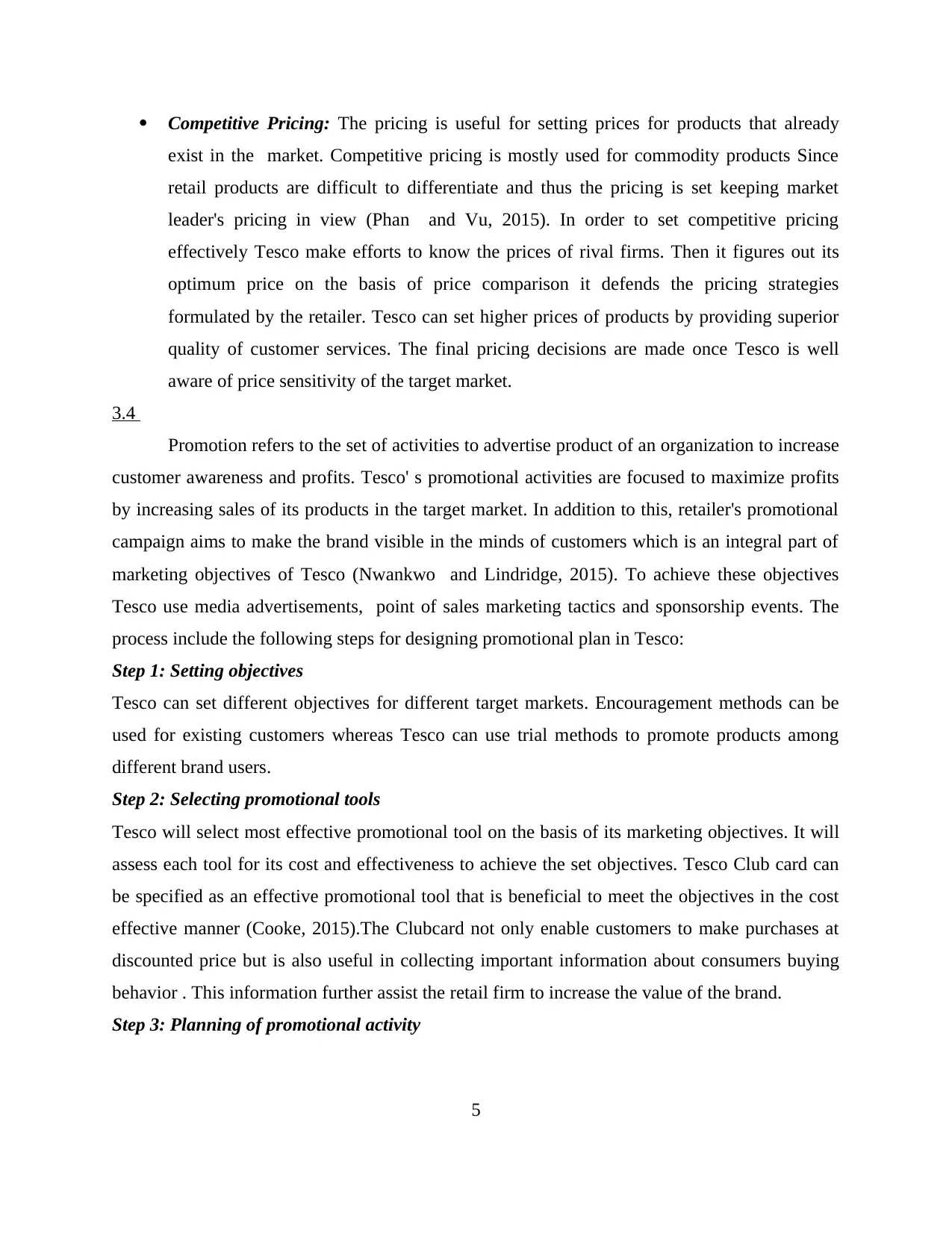
Competitive Pricing: The pricing is useful for setting prices for products that already
exist in the market. Competitive pricing is mostly used for commodity products Since
retail products are difficult to differentiate and thus the pricing is set keeping market
leader's pricing in view (Phan and Vu, 2015). In order to set competitive pricing
effectively Tesco make efforts to know the prices of rival firms. Then it figures out its
optimum price on the basis of price comparison it defends the pricing strategies
formulated by the retailer. Tesco can set higher prices of products by providing superior
quality of customer services. The final pricing decisions are made once Tesco is well
aware of price sensitivity of the target market.
3.4
Promotion refers to the set of activities to advertise product of an organization to increase
customer awareness and profits. Tesco' s promotional activities are focused to maximize profits
by increasing sales of its products in the target market. In addition to this, retailer's promotional
campaign aims to make the brand visible in the minds of customers which is an integral part of
marketing objectives of Tesco (Nwankwo and Lindridge, 2015). To achieve these objectives
Tesco use media advertisements, point of sales marketing tactics and sponsorship events. The
process include the following steps for designing promotional plan in Tesco:
Step 1: Setting objectives
Tesco can set different objectives for different target markets. Encouragement methods can be
used for existing customers whereas Tesco can use trial methods to promote products among
different brand users.
Step 2: Selecting promotional tools
Tesco will select most effective promotional tool on the basis of its marketing objectives. It will
assess each tool for its cost and effectiveness to achieve the set objectives. Tesco Club card can
be specified as an effective promotional tool that is beneficial to meet the objectives in the cost
effective manner (Cooke, 2015).The Clubcard not only enable customers to make purchases at
discounted price but is also useful in collecting important information about consumers buying
behavior . This information further assist the retail firm to increase the value of the brand.
Step 3: Planning of promotional activity
5
exist in the market. Competitive pricing is mostly used for commodity products Since
retail products are difficult to differentiate and thus the pricing is set keeping market
leader's pricing in view (Phan and Vu, 2015). In order to set competitive pricing
effectively Tesco make efforts to know the prices of rival firms. Then it figures out its
optimum price on the basis of price comparison it defends the pricing strategies
formulated by the retailer. Tesco can set higher prices of products by providing superior
quality of customer services. The final pricing decisions are made once Tesco is well
aware of price sensitivity of the target market.
3.4
Promotion refers to the set of activities to advertise product of an organization to increase
customer awareness and profits. Tesco' s promotional activities are focused to maximize profits
by increasing sales of its products in the target market. In addition to this, retailer's promotional
campaign aims to make the brand visible in the minds of customers which is an integral part of
marketing objectives of Tesco (Nwankwo and Lindridge, 2015). To achieve these objectives
Tesco use media advertisements, point of sales marketing tactics and sponsorship events. The
process include the following steps for designing promotional plan in Tesco:
Step 1: Setting objectives
Tesco can set different objectives for different target markets. Encouragement methods can be
used for existing customers whereas Tesco can use trial methods to promote products among
different brand users.
Step 2: Selecting promotional tools
Tesco will select most effective promotional tool on the basis of its marketing objectives. It will
assess each tool for its cost and effectiveness to achieve the set objectives. Tesco Club card can
be specified as an effective promotional tool that is beneficial to meet the objectives in the cost
effective manner (Cooke, 2015).The Clubcard not only enable customers to make purchases at
discounted price but is also useful in collecting important information about consumers buying
behavior . This information further assist the retail firm to increase the value of the brand.
Step 3: Planning of promotional activity
5
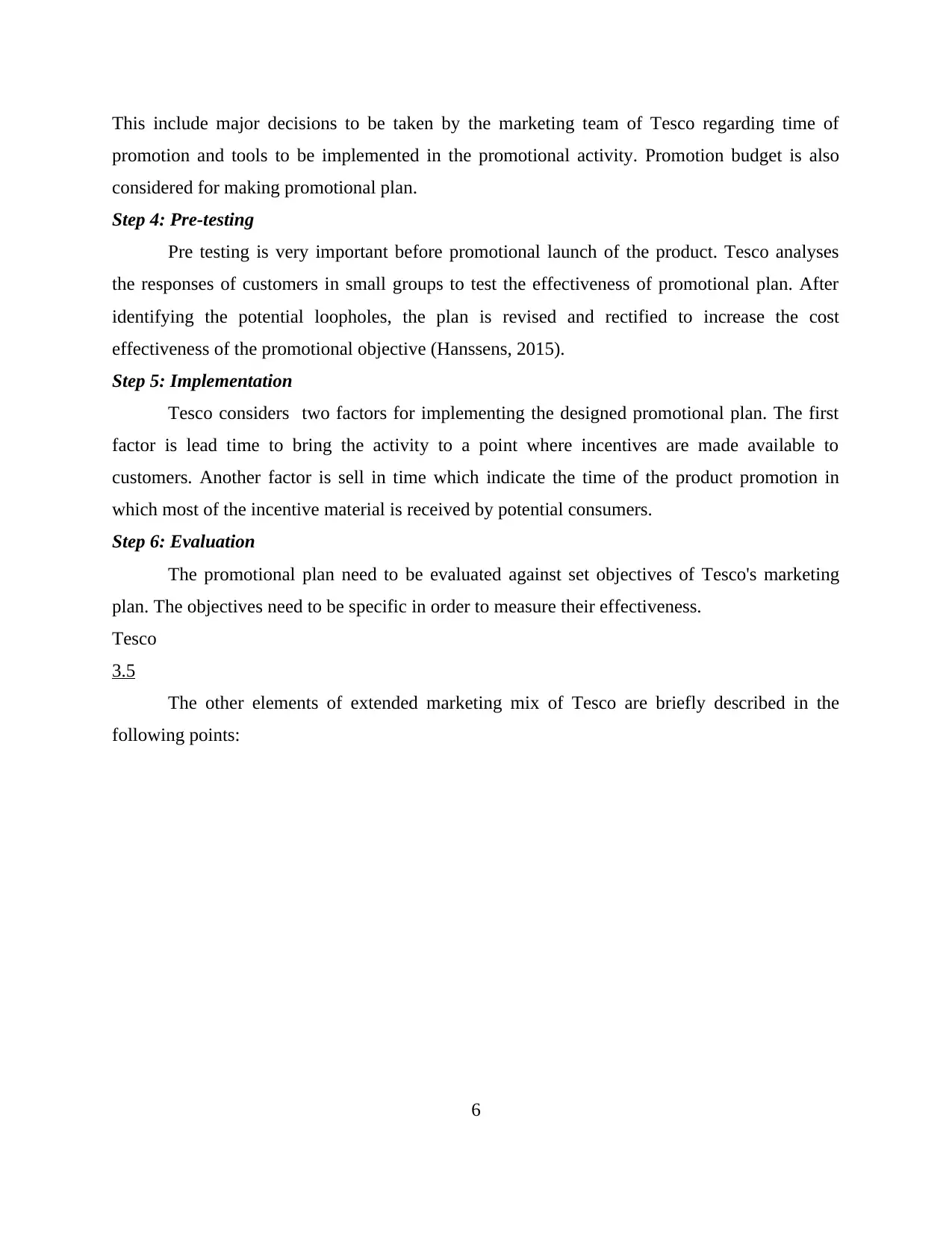
This include major decisions to be taken by the marketing team of Tesco regarding time of
promotion and tools to be implemented in the promotional activity. Promotion budget is also
considered for making promotional plan.
Step 4: Pre-testing
Pre testing is very important before promotional launch of the product. Tesco analyses
the responses of customers in small groups to test the effectiveness of promotional plan. After
identifying the potential loopholes, the plan is revised and rectified to increase the cost
effectiveness of the promotional objective (Hanssens, 2015).
Step 5: Implementation
Tesco considers two factors for implementing the designed promotional plan. The first
factor is lead time to bring the activity to a point where incentives are made available to
customers. Another factor is sell in time which indicate the time of the product promotion in
which most of the incentive material is received by potential consumers.
Step 6: Evaluation
The promotional plan need to be evaluated against set objectives of Tesco's marketing
plan. The objectives need to be specific in order to measure their effectiveness.
Tesco
3.5
The other elements of extended marketing mix of Tesco are briefly described in the
following points:
6
promotion and tools to be implemented in the promotional activity. Promotion budget is also
considered for making promotional plan.
Step 4: Pre-testing
Pre testing is very important before promotional launch of the product. Tesco analyses
the responses of customers in small groups to test the effectiveness of promotional plan. After
identifying the potential loopholes, the plan is revised and rectified to increase the cost
effectiveness of the promotional objective (Hanssens, 2015).
Step 5: Implementation
Tesco considers two factors for implementing the designed promotional plan. The first
factor is lead time to bring the activity to a point where incentives are made available to
customers. Another factor is sell in time which indicate the time of the product promotion in
which most of the incentive material is received by potential consumers.
Step 6: Evaluation
The promotional plan need to be evaluated against set objectives of Tesco's marketing
plan. The objectives need to be specific in order to measure their effectiveness.
Tesco
3.5
The other elements of extended marketing mix of Tesco are briefly described in the
following points:
6
⊘ This is a preview!⊘
Do you want full access?
Subscribe today to unlock all pages.

Trusted by 1+ million students worldwide
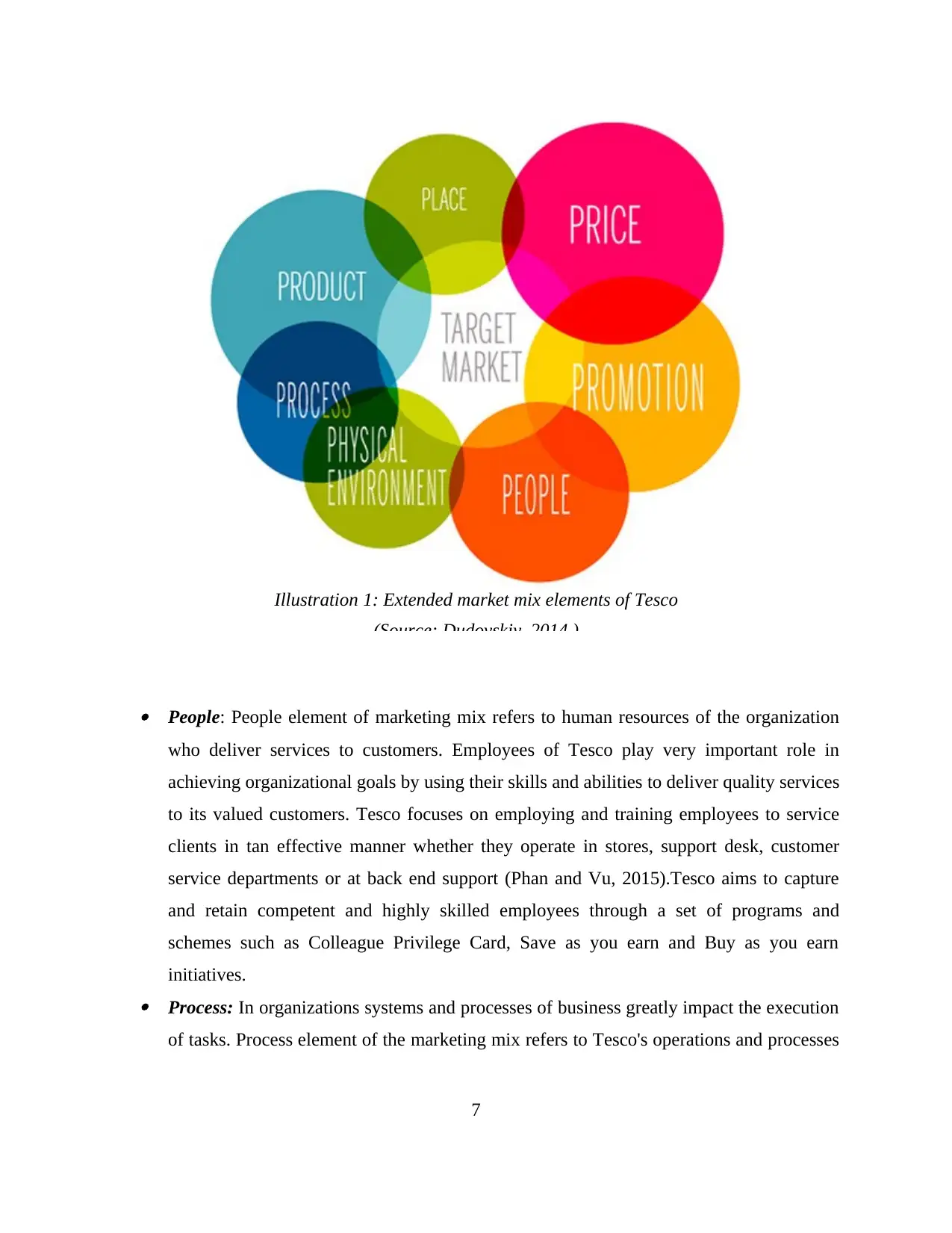
People: People element of marketing mix refers to human resources of the organization
who deliver services to customers. Employees of Tesco play very important role in
achieving organizational goals by using their skills and abilities to deliver quality services
to its valued customers. Tesco focuses on employing and training employees to service
clients in tan effective manner whether they operate in stores, support desk, customer
service departments or at back end support (Phan and Vu, 2015).Tesco aims to capture
and retain competent and highly skilled employees through a set of programs and
schemes such as Colleague Privilege Card, Save as you earn and Buy as you earn
initiatives. Process: In organizations systems and processes of business greatly impact the execution
of tasks. Process element of the marketing mix refers to Tesco's operations and processes
7
Illustration 1: Extended market mix elements of Tesco
(Source: Dudovskiy, 2014 )
who deliver services to customers. Employees of Tesco play very important role in
achieving organizational goals by using their skills and abilities to deliver quality services
to its valued customers. Tesco focuses on employing and training employees to service
clients in tan effective manner whether they operate in stores, support desk, customer
service departments or at back end support (Phan and Vu, 2015).Tesco aims to capture
and retain competent and highly skilled employees through a set of programs and
schemes such as Colleague Privilege Card, Save as you earn and Buy as you earn
initiatives. Process: In organizations systems and processes of business greatly impact the execution
of tasks. Process element of the marketing mix refers to Tesco's operations and processes
7
Illustration 1: Extended market mix elements of Tesco
(Source: Dudovskiy, 2014 )
Paraphrase This Document
Need a fresh take? Get an instant paraphrase of this document with our AI Paraphraser
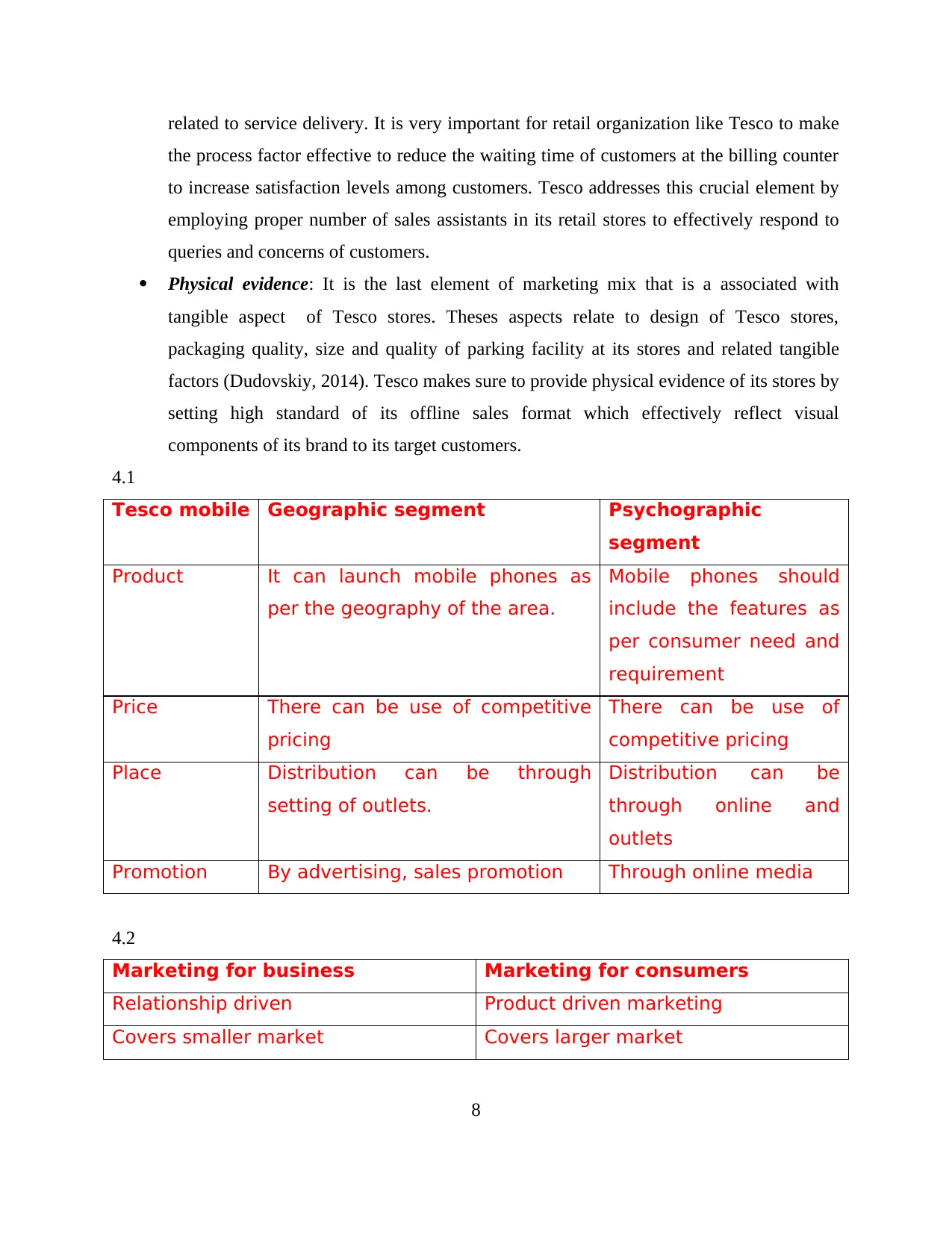
related to service delivery. It is very important for retail organization like Tesco to make
the process factor effective to reduce the waiting time of customers at the billing counter
to increase satisfaction levels among customers. Tesco addresses this crucial element by
employing proper number of sales assistants in its retail stores to effectively respond to
queries and concerns of customers.
Physical evidence: It is the last element of marketing mix that is a associated with
tangible aspect of Tesco stores. Theses aspects relate to design of Tesco stores,
packaging quality, size and quality of parking facility at its stores and related tangible
factors (Dudovskiy, 2014). Tesco makes sure to provide physical evidence of its stores by
setting high standard of its offline sales format which effectively reflect visual
components of its brand to its target customers.
4.1
Tesco mobile Geographic segment Psychographic
segment
Product It can launch mobile phones as
per the geography of the area.
Mobile phones should
include the features as
per consumer need and
requirement
Price There can be use of competitive
pricing
There can be use of
competitive pricing
Place Distribution can be through
setting of outlets.
Distribution can be
through online and
outlets
Promotion By advertising, sales promotion Through online media
4.2
Marketing for business Marketing for consumers
Relationship driven Product driven marketing
Covers smaller market Covers larger market
8
the process factor effective to reduce the waiting time of customers at the billing counter
to increase satisfaction levels among customers. Tesco addresses this crucial element by
employing proper number of sales assistants in its retail stores to effectively respond to
queries and concerns of customers.
Physical evidence: It is the last element of marketing mix that is a associated with
tangible aspect of Tesco stores. Theses aspects relate to design of Tesco stores,
packaging quality, size and quality of parking facility at its stores and related tangible
factors (Dudovskiy, 2014). Tesco makes sure to provide physical evidence of its stores by
setting high standard of its offline sales format which effectively reflect visual
components of its brand to its target customers.
4.1
Tesco mobile Geographic segment Psychographic
segment
Product It can launch mobile phones as
per the geography of the area.
Mobile phones should
include the features as
per consumer need and
requirement
Price There can be use of competitive
pricing
There can be use of
competitive pricing
Place Distribution can be through
setting of outlets.
Distribution can be
through online and
outlets
Promotion By advertising, sales promotion Through online media
4.2
Marketing for business Marketing for consumers
Relationship driven Product driven marketing
Covers smaller market Covers larger market
8
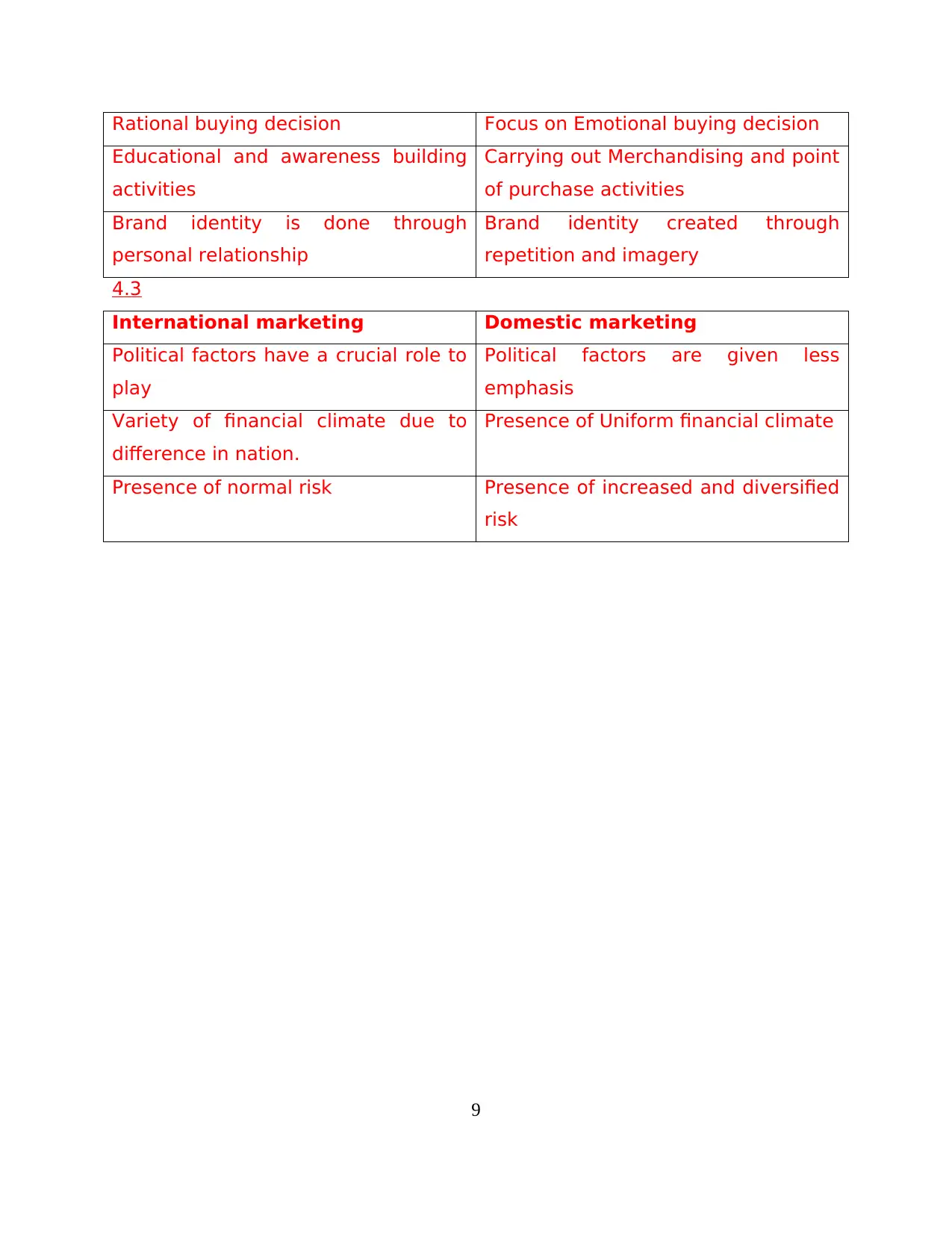
Rational buying decision Focus on Emotional buying decision
Educational and awareness building
activities
Carrying out Merchandising and point
of purchase activities
Brand identity is done through
personal relationship
Brand identity created through
repetition and imagery
4.3
International marketing Domestic marketing
Political factors have a crucial role to
play
Political factors are given less
emphasis
Variety of financial climate due to
difference in nation.
Presence of Uniform financial climate
Presence of normal risk Presence of increased and diversified
risk
9
Educational and awareness building
activities
Carrying out Merchandising and point
of purchase activities
Brand identity is done through
personal relationship
Brand identity created through
repetition and imagery
4.3
International marketing Domestic marketing
Political factors have a crucial role to
play
Political factors are given less
emphasis
Variety of financial climate due to
difference in nation.
Presence of Uniform financial climate
Presence of normal risk Presence of increased and diversified
risk
9
⊘ This is a preview!⊘
Do you want full access?
Subscribe today to unlock all pages.

Trusted by 1+ million students worldwide
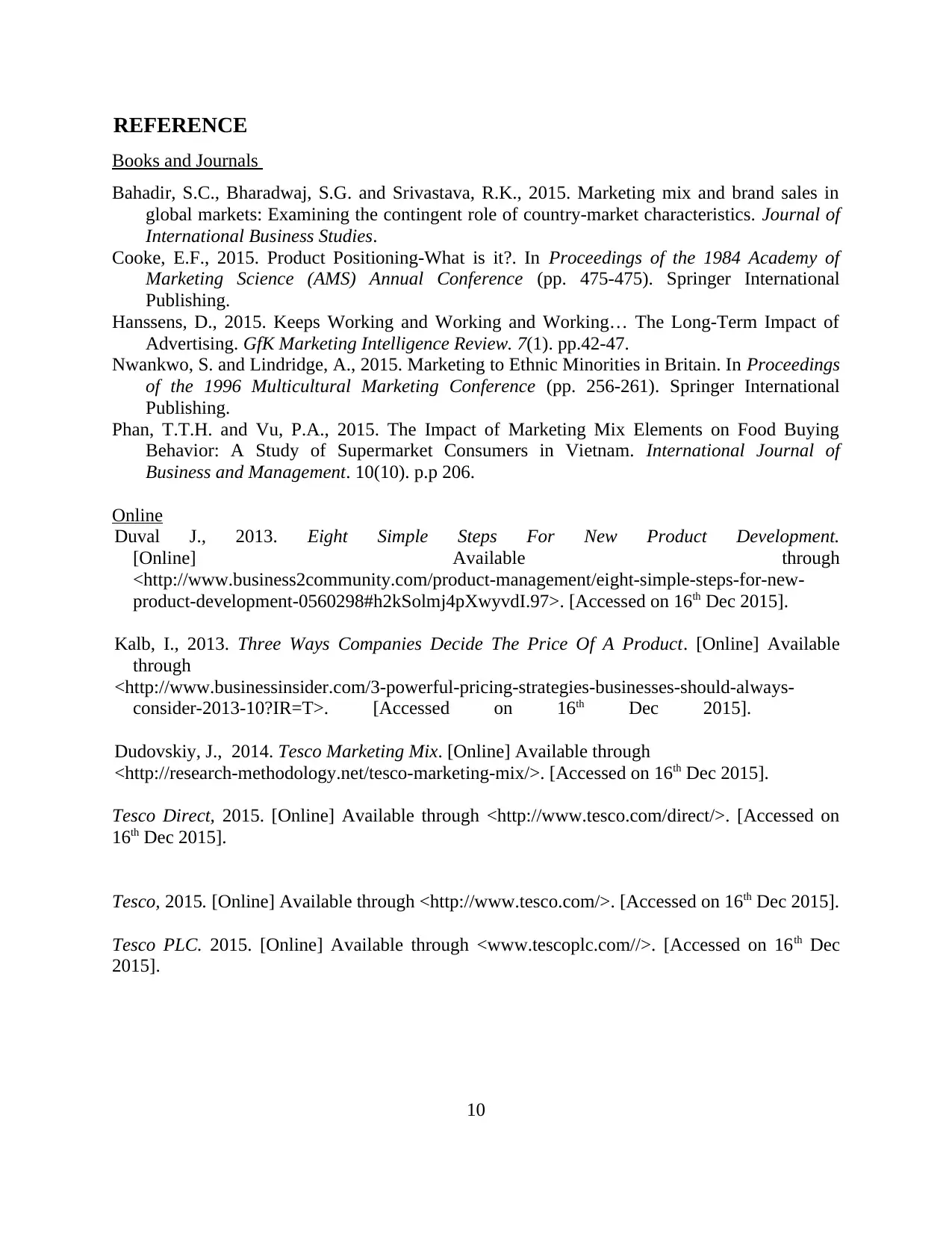
REFERENCE
Books and Journals
Bahadir, S.C., Bharadwaj, S.G. and Srivastava, R.K., 2015. Marketing mix and brand sales in
global markets: Examining the contingent role of country-market characteristics. Journal of
International Business Studies.
Cooke, E.F., 2015. Product Positioning-What is it?. In Proceedings of the 1984 Academy of
Marketing Science (AMS) Annual Conference (pp. 475-475). Springer International
Publishing.
Hanssens, D., 2015. Keeps Working and Working and Working… The Long-Term Impact of
Advertising. GfK Marketing Intelligence Review. 7(1). pp.42-47.
Nwankwo, S. and Lindridge, A., 2015. Marketing to Ethnic Minorities in Britain. In Proceedings
of the 1996 Multicultural Marketing Conference (pp. 256-261). Springer International
Publishing.
Phan, T.T.H. and Vu, P.A., 2015. The Impact of Marketing Mix Elements on Food Buying
Behavior: A Study of Supermarket Consumers in Vietnam. International Journal of
Business and Management. 10(10). p.p 206.
Online
Duval J., 2013. Eight Simple Steps For New Product Development.
[Online] Available through
<http://www.business2community.com/product-management/eight-simple-steps-for-new-
product-development-0560298#h2kSolmj4pXwyvdI.97>. [Accessed on 16th Dec 2015].
Kalb, I., 2013. Three Ways Companies Decide The Price Of A Product. [Online] Available
through
<http://www.businessinsider.com/3-powerful-pricing-strategies-businesses-should-always-
consider-2013-10?IR=T>. [Accessed on 16th Dec 2015].
Dudovskiy, J., 2014. Tesco Marketing Mix. [Online] Available through
<http://research-methodology.net/tesco-marketing-mix/>. [Accessed on 16th Dec 2015].
Tesco Direct, 2015. [Online] Available through <http://www.tesco.com/direct/>. [Accessed on
16th Dec 2015].
Tesco, 2015. [Online] Available through <http://www.tesco.com/>. [Accessed on 16th Dec 2015].
Tesco PLC. 2015. [Online] Available through <www.tescoplc.com//>. [Accessed on 16th Dec
2015].
10
Books and Journals
Bahadir, S.C., Bharadwaj, S.G. and Srivastava, R.K., 2015. Marketing mix and brand sales in
global markets: Examining the contingent role of country-market characteristics. Journal of
International Business Studies.
Cooke, E.F., 2015. Product Positioning-What is it?. In Proceedings of the 1984 Academy of
Marketing Science (AMS) Annual Conference (pp. 475-475). Springer International
Publishing.
Hanssens, D., 2015. Keeps Working and Working and Working… The Long-Term Impact of
Advertising. GfK Marketing Intelligence Review. 7(1). pp.42-47.
Nwankwo, S. and Lindridge, A., 2015. Marketing to Ethnic Minorities in Britain. In Proceedings
of the 1996 Multicultural Marketing Conference (pp. 256-261). Springer International
Publishing.
Phan, T.T.H. and Vu, P.A., 2015. The Impact of Marketing Mix Elements on Food Buying
Behavior: A Study of Supermarket Consumers in Vietnam. International Journal of
Business and Management. 10(10). p.p 206.
Online
Duval J., 2013. Eight Simple Steps For New Product Development.
[Online] Available through
<http://www.business2community.com/product-management/eight-simple-steps-for-new-
product-development-0560298#h2kSolmj4pXwyvdI.97>. [Accessed on 16th Dec 2015].
Kalb, I., 2013. Three Ways Companies Decide The Price Of A Product. [Online] Available
through
<http://www.businessinsider.com/3-powerful-pricing-strategies-businesses-should-always-
consider-2013-10?IR=T>. [Accessed on 16th Dec 2015].
Dudovskiy, J., 2014. Tesco Marketing Mix. [Online] Available through
<http://research-methodology.net/tesco-marketing-mix/>. [Accessed on 16th Dec 2015].
Tesco Direct, 2015. [Online] Available through <http://www.tesco.com/direct/>. [Accessed on
16th Dec 2015].
Tesco, 2015. [Online] Available through <http://www.tesco.com/>. [Accessed on 16th Dec 2015].
Tesco PLC. 2015. [Online] Available through <www.tescoplc.com//>. [Accessed on 16th Dec
2015].
10
1 out of 10
Related Documents
Your All-in-One AI-Powered Toolkit for Academic Success.
+13062052269
info@desklib.com
Available 24*7 on WhatsApp / Email
![[object Object]](/_next/static/media/star-bottom.7253800d.svg)
Unlock your academic potential
Copyright © 2020–2025 A2Z Services. All Rights Reserved. Developed and managed by ZUCOL.





